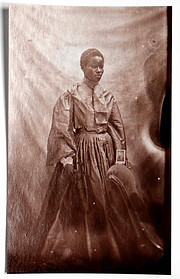WET PLATE AND ALBUMEN

The rarity, displacement and anonymity of woman of colour in European photo archives, best exemplified by Bonetta herself, made me further examine European photo archives, and reflect on the racial and gender differences in our shared history and in the present. For this ongoing project, I conducted an experiment with an original and exceptionally rare 1861 French carte-de-visite studio camera. This camera utilized the same wet plate negative (collodion) method that was employed to create cartes-de-visite during their inception more than 170 years ago. Only five of these original studio cameras remain in the world. Four of these are held in museums, while the remaining one is in the private collection of F. Hoch, who graciously allowed me to work with it. It is believed that this camera portrayed only white people in 19th Century Europe.
Employing this original camera to create works for the BLOOM series is also about correcting injustices on a micro-level. I created albumen prints from the glass plate negatives, including self-portraits. The sitter is my co-author Penda Mbaye, who migrated from Conakry to Belgium more than a decade ago. She delicately holds in her hand a rare carte de visite from around 1865, which was captured in a European studio. This portrait features an unidentified woman of color whose history has been shrouded in mystery and forgotten in European archives. Mbaye and I use flowers to encode thoughtful messages relating to remembrance and permanence, challenging the European perspective on remembrance and memory.












